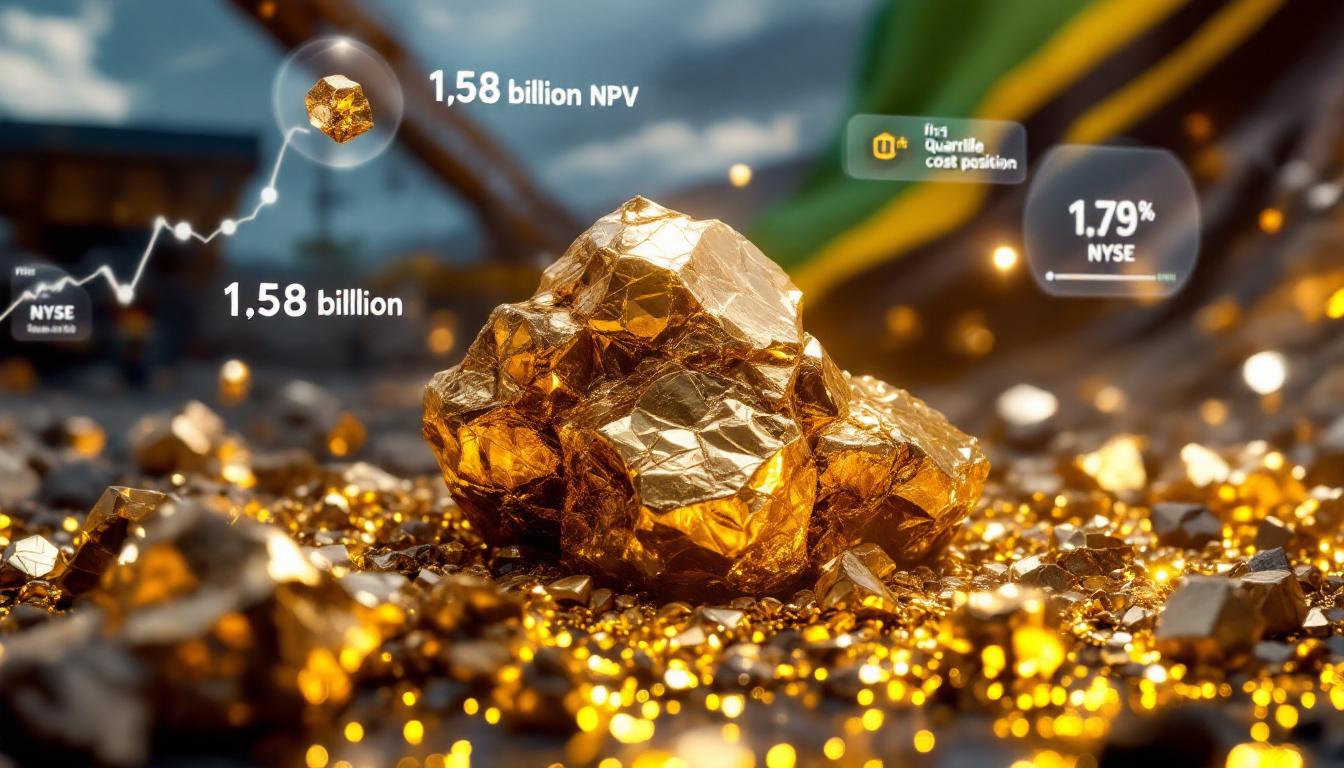Understanding the Recent Wave of Mining Royalty Consolidation
Royal Gold's $3.5B Acquisition of Sandstorm Gold
The mining royalty landscape is experiencing unprecedented transformation, headlined by Royal Gold's landmark $3.5 billion acquisition of Sandstorm Gold. This transaction represents approximately 17 times Sandstorm's annualized cash flow of $200 million, signaling strong confidence in the long-term value of diversified royalty portfolios.
The deal's significance extends beyond its dollar value, as it brings together complementary assets that strengthen Royal Gold's market position. By acquiring Sandstorm's portfolio of over 200 royalties, Royal Gold has effectively doubled its asset base while gaining exposure to a broader range of commodities and jurisdictions.
Key Transaction Data
Metric Value Transaction Value $3.5 billion Cash Flow Multiple ~17x Assets Acquired 200+ royalties Portfolio Expansion ~100% increase
The Strategic Value of Portfolio Diversification
Portfolio diversification represents a core strategic advantage in the mining royalty sector consolidation business model. Unlike traditional mining operations that concentrate risk in specific projects, royalty companies can spread exposure across numerous assets, development stages, and geographies.
The Sandstorm acquisition exemplifies this strategy, with Royal Gold gaining access to hundreds of royalties across different commodities and jurisdictions. This diversification provides natural hedging against project-specific risks, including:
- Operational disruptions at individual mines
- Permitting delays in specific jurisdictions
- Commodity price volatility in particular metals
- Political risks in certain regions
Industry experts note that this approach contrasts sharply with concentrated investment strategies that place substantial capital in single assets. The diversification benefit becomes particularly valuable during periods of market volatility or when individual projects face challenges.
Comparing Consolidation Approaches: Multi-Asset vs. Single-Asset Strategies
Two distinct consolidation strategies have emerged in the royalty sector: multi-asset portfolio acquisitions and concentrated single-asset investments. Each approach offers different risk-reward profiles and strategic benefits.
Multi-Asset Portfolio Acquisitions:
- Royal Gold-Sandstorm: 200+ royalties for $3.5 billion
- Triple Flag's acquisition of Orogen Royalties: $305 million
- Eagle Royalties-Summit Royalty combination
Single-Asset Concentrated Investments:
- Franco Nevada's $1 billion investment in Cobre Panama
- Various streaming deals focused on individual development projects
The multi-asset approach typically provides immediate diversification benefits and operational synergies. With minimal incremental overhead required to manage additional royalties, these transactions can quickly enhance financial performance. As Brendan Yurik, CEO of Electric Royalties, noted: "I love the Sandstorm deal… They're hedging risk across 200 different assets. Franco Nevada's $1B Cobre Panama investment became a liability after nationalization."
Single-asset strategies, while potentially offering higher returns from specific high-quality projects, concentrate risk and tie performance to the success of individual operations. The recent nationalization of First Quantum's Cobre Panama mine demonstrates the potential downside of concentrated exposure, with Franco Nevada experiencing significant value impairment from this single investment.
What's Driving Non-Traditional Capital into Mining Royalties?
Digital Asset Companies Enter the Mining Space
A remarkable development in the mining finance landscape is the entrance of digital asset companies into the royalty and streaming sector. Most notably, Tether, a stablecoin issuer with reported annual revenues of $45 billion, has made strategic investments in Elemental Altus Royalties, signaling a significant shift in capital sources.
This trend reflects growing recognition that digital infrastructure ultimately depends on physical resources. As Brendan Yurik observed: "Digital asset firms realize AI and tech platforms depend on our metals. Governments now prioritize mineral security—this isn't just about returns."
The entrance of digital asset companies brings several advantages to the mining sector:
- Access to substantial capital pools previously unavailable to resource companies
- Potential for innovative financing structures leveraging digital assets
- Enhanced visibility of mining investments among technology investors
- Strategic alignment between digital growth and critical minerals energy security
This convergence between digital and physical asset investors suggests a broader recognition that technological advancement remains fundamentally dependent on mineral resources, particularly those essential to energy transition and digital infrastructure.
Government Strategic Investments in Critical Minerals
Government capital is increasingly flowing into the mining sector through strategic investments aimed at securing supply chains for critical minerals. This represents a paradigm shift from historical approaches where governments primarily engaged through regulation rather than direct investment.
The trend reflects growing recognition of mineral security as a national priority, particularly for materials essential to defence critical minerals strategy applications, energy transition, and advanced manufacturing. Unlike traditional mining finance that focuses primarily on financial returns, government investments prioritize supply chain resilience and national security considerations.
The Pentagon's $400M Mountain Pass Investment
A landmark example of government strategic investment is the Pentagon's $400 million commitment to MP Materials' Mountain Pass rare earth element operation. This transaction includes:
- $400 million in direct investment
- A 10-year off-take agreement for neodymium-praseodymium (NdPr)
- Pricing approximately 70% above market rates
- Domestic processing requirements to ensure supply chain security
This arrangement demonstrates how government capital can provide both financial support and market certainty for critical mineral projects. By guaranteeing both purchase volumes and premium pricing, the Pentagon has effectively de-risked the operation while securing access to materials essential for defense applications.
Supply Chain Security as a National Priority
The increasing government involvement in mining finance reflects a fundamental shift in how nations view mineral resources. Rather than treating commodities as fungible global products, policymakers increasingly recognize certain minerals as strategic assets requiring domestic control or guaranteed access.
This perspective has emerged from several converging factors:
- Geopolitical tensions increasing concerns about supply disruptions
- Energy transition targets requiring massive mineral inputs
- Defense technology depending on specialized materials
- Concentration of processing capacity in specific countries
- Historical underinvestment in domestic mineral development
As one industry observer noted, "It's the first real sign of the US actually taking control of their mineral supply chain." This trend suggests potential for expanded government involvement in financing mining projects considered strategically important, particularly those focused on battery metals, rare earth elements, and other critical minerals.
Why Do Valuation Gaps Persist in the Royalty Sector?
Market Disconnects: Metal Price Performance vs. Equity Valuations
A persistent paradox in the mining sector is the disconnect between strong commodity price performance and relatively subdued equity valuations. Despite many metals doubling in price over recent years, mining equities have generally failed to capture corresponding valuation growth.
This divergence is particularly notable when comparing mining stocks to broader market indices. While the S&P 500 has reached new highs, many mining companies trade at valuations that imply significantly lower long-term commodity prices than current spot rates. This disconnect creates potential opportunities for investors who recognize the fundamental value gap.
Several factors contribute to this valuation disconnect:
- Institutional allocation shifts away from natural resource sectors
- ESG concerns creating headwinds for mining investment
- Historical volatility making investors cautious about cyclical upswings
- Capital discipline from companies limiting growth investment
- Geopolitical uncertainties affecting long-term project development
The persistence of this valuation gap suggests potential for significant re-rating as market perceptions evolve or as companies demonstrate consistent financial performance through commodity price cycles.
Comparative Multiples: Junior vs. Senior Royalty Companies
A notable valuation disparity exists between established royalty majors and emerging junior royalty companies. While sector leaders like Franco Nevada, Wheaton Precious Metals, and Royal Gold typically command valuation multiples of 15-20 times cash flow, smaller royalty companies often trade at 8-12 times multiples despite similar business models.
This valuation gap creates potential opportunities for investors and strategic acquirers who recognize the fundamental similarities in business quality. The royalty business model offers several advantages regardless of company size:
- Asset-light operations requiring minimal capital expenditure
- Portfolio diversification across multiple projects
- Inflation protection through direct commodity price exposure
- Limited operational risk compared to mining operators
- Significant free cash flow generation potential
For emerging royalty companies approaching cash flow positivity, this valuation disconnect suggests potential for significant re-rating as they demonstrate consistent financial performance and attract greater investor attention.
Liquidity Premium and Market Inefficiencies
Market liquidity plays a significant role in the valuation disparities between larger and smaller royalty companies. Established royalty majors benefit from:
- Inclusion in major indices
- Broad institutional ownership
- Analyst coverage from major financial institutions
- Higher trading volumes supporting larger positions
- Dividend histories attracting income-oriented investors
These liquidity advantages command a premium valuation that may exceed differences in fundamental business quality. For smaller royalty companies, limited trading volumes and narrower investor bases can create persistent valuation inefficiencies despite strong underlying asset quality.
This dynamic creates opportunities for investors willing to accept lower liquidity in exchange for exposure to undervalued royalty portfolios. As smaller companies grow and attract greater market attention, the liquidity discount typically narrows, potentially providing additional returns beyond fundamental business growth.
Re-Rating Potential as Companies Approach Cash Flow Positivity
A critical valuation inflection point for royalty companies occurs as they transition from development-stage portfolios to consistent cash flow generation. This evolution typically triggers multiple expansion as investors gain confidence in financial performance and reduced execution risk.
For companies with portfolios of development-stage royalties, near-term production milestones can catalyze significant valuation re-ratings. This transition offers asymmetric return potential as companies demonstrate the cash-generating capability of their existing asset base without requiring additional capital deployment.
The re-rating process typically follows a predictable pattern:
- Initial undervaluation during portfolio construction phase
- Gradual multiple expansion as projects advance toward production
- Step-change revaluation when consistent cash flow is demonstrated
- Further appreciation as cash flow grows and dividend potential emerges
For investors, identifying royalty companies approaching this inflection point can provide opportunities to benefit from both fundamental business growth and valuation multiple expansion.
How Are Clean Energy Metals Changing the Royalty Landscape?
Emerging Opportunities Beyond Precious Metals
While precious metals have historically dominated the royalty sector, clean energy metals represent an emerging frontier with substantial growth potential. This evolution reflects broader market trends as energy transition technologies drive increasing demand for battery metals, rare earth elements, and other critical minerals.
The clean energy metals royalty space offers several distinctive advantages:
- Structural growth drivers from electrification and decarbonization
- Limited competition compared to the crowded precious metals space
- Earlier-stage entry points before asset values fully reflect future demand
- Diversification benefits for investors seeking broader commodity exposure
- Strategic alignment with global energy transition priorities
Unlike precious metals, which primarily serve monetary and jewelry applications, clean energy metals directly support industrial transformation toward renewable energy, electric vehicles, and grid modernization. This connection to structural growth trends provides potential for sustained demand expansion rather than cyclical fluctuations.
Supply Dynamics and Pricing Power in Critical Minerals
The supply dynamics for critical minerals differ fundamentally from traditional mining commodities, creating distinctive opportunities for royalty investors. Several factors contribute to these unique market characteristics:
- Geological scarcity of high-quality deposits in accessible jurisdictions
- Technical complexity in processing and refining certain materials
- Long development timelines for new production capacity
- Concentration of existing production in specific countries
- Accelerating demand growth from energy transition applications
As Brendan Yurik observed: "Critical metals have way fewer options—maybe one or two deposits per jurisdiction. This scarcity creates pricing power."
This supply constraint dynamic creates potential for significant pricing power, as demonstrated by lithium's 19-fold price increase during its recent bull market. Similar supply-demand imbalances could emerge across other critical minerals as electrification accelerates, potentially benefiting royalty holders with exposure to quality assets in secure jurisdictions.
Competitive Landscape Analysis: Limited Players in Battery Metals
The competitive landscape for battery metals royalties remains significantly less crowded than the precious metals space. While dozens of companies compete for gold MA consolidation opportunities, only a handful of specialized firms focus on clean energy metals.
This limited competition creates several strategic advantages:
- More favorable acquisition terms due to fewer competing bidders
- Relationship advantages with development companies seeking financing
- Specialized expertise that can identify undervalued opportunities
- First-mover benefits in establishing portfolio positions
For companies like Electric Royalties, which has assembled a portfolio of 43 royalties focused on battery metals and critical minerals, this specialization provides a distinctive market position. As Brendan Yurik noted, "There's only a few groups out there for some of these deals that we're talking about," highlighting the opportunity to secure attractive terms in a less competitive environment.
Case Study: Lithium's Price Performance During Recent Bull Market
Lithium's recent market performance demonstrates the potential volatility and upside in critical mineral markets. During its bull market phase, lithium prices increased approximately 19-fold before subsequently correcting, highlighting both the opportunity and risk in emerging commodity markets.
This price performance reflects several distinctive characteristics of critical mineral markets:
- Inelastic short-term supply due to long project development timelines
- Accelerating demand growth from electric vehicle adoption
- Limited substitution potential in battery applications
- Concentrated production in specific countries and companies
- Strategic importance driving non-market interventions
For royalty investors, this volatility presents both challenges and opportunities. Unlike precious metals royalties, which typically provide more stable cash flows, critical mineral royalties may offer higher growth potential but with greater price volatility. This dynamic makes portfolio diversification particularly important for companies focused on these emerging sectors.
What Growth Strategies Are Emerging for Royalty Companies?
Private Equity Partnerships as Alternatives to M&A
An innovative growth strategy emerging in the royalty sector involves partnerships with private equity firms to fund transaction growth without diluting existing shareholders. This approach addresses the valuation challenges that make traditional equity-funded M&A potentially destructive to shareholder value at current market multiples.
The partnership model typically involves:
- Royalty companies originating and structuring potential transactions
- Private equity partners providing majority funding
- Royalty companies retaining minority interests without capital deployment
- Shared economics that align incentives while preserving capital
A notable example is Electric Royalties' partnership with Sprott Resource Streaming and Royalty, where Sprott provided 100% of the $13.5 million investment for the Middle Tennessee Mine royalty acquisition. Electric Royalties retained 25% of the royalty without capital deployment, demonstrating how these structures can provide portfolio growth without dilution.
This approach is particularly valuable during periods of depressed equity valuations, allowing royalty companies to continue building their asset bases while preserving capital for selective opportunities where they can deploy their own funds more advantageously.
Deal Origination Without Shareholder Dilution
The private equity partnership model addresses a critical challenge for emerging royalty companies: how to grow without continuous equity issuance that dilutes existing shareholders. By leveraging partnerships to access capital while maintaining partial exposure to new assets, companies can achieve growth while preserving their capital structure.
As Brendan Yurik explained: "We coordinate with private equity to fund deals without dilution. Our model scales with near-zero administrative cost." This approach allows royalty companies to focus on their core competency—identifying and structuring attractive royalty transactions—while partnering with capital providers who have complementary capabilities.
The benefits of this strategy include:
- Preserving shareholder value during periods of depressed equity valuations
- Maintaining future flexibility by avoiding excessive debt or equity issuance
- Creating optionality to fully acquire high-performing assets in the future
- Building relationships with institutional investors for potential future capital access
- Demonstrating capital discipline and financial innovation to the market
For investors, this approach represents a more sustainable growth model than the traditional cycle of continuous equity issuance to fund new acquisitions, particularly for companies trading at discounted valuations.
Operational Efficiencies in the Royalty Business Model
The fundamental operational efficiency of the royalty business model creates exceptional scaling potential that few other business models can match. Unlike traditional mining operations that require proportional staff and overhead growth as they expand, royalty companies can add substantial assets with minimal incremental operating costs.
This efficiency is demonstrated by industry leaders like Franco Nevada, which manages a $40 billion portfolio with approximately 25 employees. The model works because royalties:
- Require minimal ongoing administration once structured
- Involve standardized legal documentation and monitoring
- Eliminate operational management responsibilities
- Can be tracked through automated financial systems
- Benefit from natural portfolio diversification as they scale
For emerging royalty companies, this operational leverage means each additional royalty acquired improves overall margins, as fixed costs are spread across a growing revenue base. This dynamic makes royalty companies exceptionally profitable at scale, with potential for 80-90% operating margins once a critical mass of producing royalties is achieved.
Cash Flow Projections and Value Inflection Points
For developing royalty companies, communicating the path to significant cash flow generation represents a critical element of investment messaging. As royalties move from development to production stages, companies can experience dramatic improvements in financial performance without deploying additional capital.
Electric
Want to Catch the Next Major Mineral Discovery?
Stay ahead of the market with Discovery Alert's proprietary Discovery IQ model, which instantly identifies significant ASX mineral discoveries and transforms complex data into actionable investment insights. Explore why historic discoveries have generated substantial returns by visiting our dedicated discoveries page and begin your 30-day free trial today.




